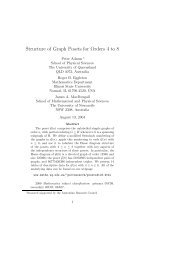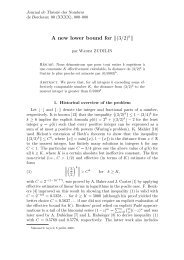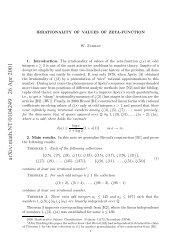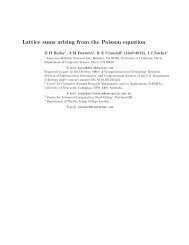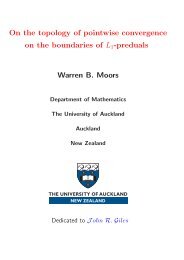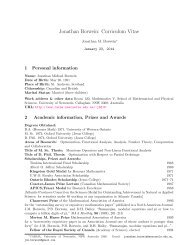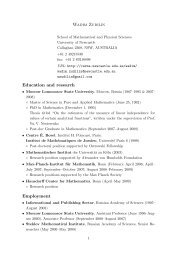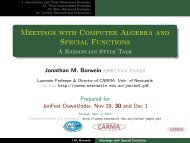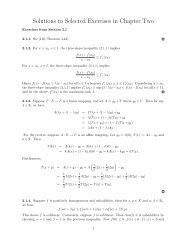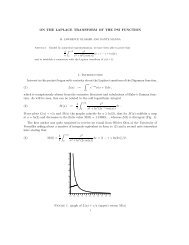QUADRATIC CONVERGENCE OF THE TANH-SINH ...
QUADRATIC CONVERGENCE OF THE TANH-SINH ...
QUADRATIC CONVERGENCE OF THE TANH-SINH ...
Create successful ePaper yourself
Turn your PDF publications into a flip-book with our unique Google optimized e-Paper software.
<strong>QUADRATIC</strong> <strong>CONVERGENCE</strong> <strong>OF</strong> <strong>THE</strong> <strong>TANH</strong>-<strong>SINH</strong> QUADRATURE RULE 9Using the change of variable u := π 2 sinh(x), and letting a := π 2sinh(nh), we get(4.4)(4.5)Applying the identitywe see thatÎF nh = π cosh(nh)2 cosh(a)(4.4) === π cosh(nh)cosh(a)∫ ∞−∞∫ ∞−∞1cosh(u − a) cosh(u) du1cosh(a) + cosh(2u − a) du.sinh(a)cosh(a) + cosh(b) = 11 + e b−a − 11 + e b+a ,∫π cosh(nh) ∞()1cosh(a) sinh(a) −∞ 1 + e 2u−2a − 11 + e 2u duπ cosh(nh)cosh(a) sinh(a) · aπ 2 sinh(2nh)(4.6)=2 sinh (π sinh(nh)) = ÎF nh.∞XBy a similar manipulation, we get ̂T n F nh =π 2 h cosh(nh)(4.7)sinh(π sinh(nh)) 1 + e − 1π sinh(rh)−π sinh(nh) 1 + e sinh(rh)cosh(rh).πTherefore(4.8) h ∑Ê h F nh = ∑×|n|>N{ ∞∑r=−∞r=−∞1|n|>Nπ 2 cosh(nh)sinh (π sinh(nh))()}11 + e − 1h cosh(rh) − sinh(nh) .π sinh(rh)−π sinh(nh) 1 + e π sinh(rh)Consider the summation∞∑()1S n :=1 + e − 1h cosh(rh),π sinh(rh)−π sinh(nh) 1 + e π sinh(rh)r=−∞and note that for h > 0∣S n = ∣e π sinh(nh) − 1∣= sinh(π/2 sinh(nh))≤sinh(π/2 sinh(nh))∞∑r=−∞= h sinh(π/2 sinh(nh))π/2 sinh(rh)e h cosh(rh)e π sinh(nh) + e π sinh(rh) 2 cosh (π/2 sinh(rh))∞∑r=−∞∞∑r=−∞{2 e π/2 sinh(nh) π/2 sinh(rh)e h cosh(rh)e π sinh(nh) + e π sinh(rh) cosh (π/2 sinh(rh))h cosh(rh)cosh(π/2 sinh(rh))1 + 2∞∑r=1cosh(rh)cosh(π/2 sinh(rh))}.



